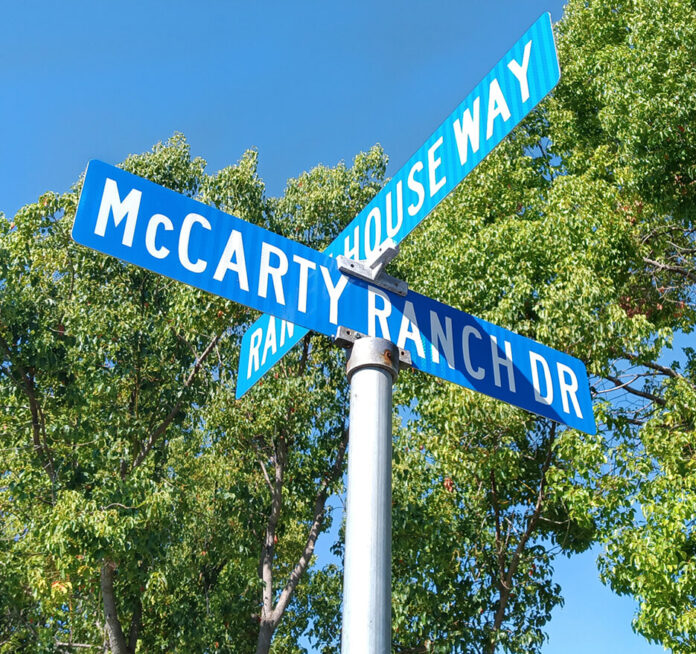History never seems to completely evaporate, it tends to seep into the fabric of the community; leaving fragments of the past in the old ruins, the trees, landforms and in the names of streets and places. Today’s maps of San Jose’s Evergreen district reflect many of the names of local historical figures and features.
To name a few instances, McCarty Ranch Drive was named after the Irishman who purchased part of the original Spanish Rancho Yerba Buena. Wehner Way commemorates German immigrant William Wehner who first established the original winery, vineyards and built the mansion that he named Lomas Azules and his estate called Villa Vista.
Cribari Village and its web of streets bear the surname of the later owners of the vineyard, the Cribari family, who were vintners and Villages pioneers. Other streets describe the ambiance of the picturesque vineyard and orchards, such as Fruit Barn Way, Olive Grove Way, Grape Wagon Circle, Vineyard Ridge Place etc.—not to mention the streets named after wines and grapes.
Not too far down the hill, Yerba Buena Road, a middle school and a transit bus yard bear the name of the original Spanish land grant and the owner, Anthony Chaboya. Rancho Yerba Buena (or Socayre) was more than 24,000 acres and contained most of Evergreen and a large portion of San Jose’s east side. In fact, until recently, there were Chaboya descendants still with the family name living at The Villages.
Most Californians are aware of the history that began at the time of the Gold Rush. Many of those who flocked into the state during that time enriched themselves on the wealth gained from those turbulent times. The Native Americans, the Spanish land grant holders and other holdovers from the Spanish and Mexican periods eventually had to yield to the great population influx of the 1850s.
The Santa Clara Valley of the nineteenth century, with its quicksilver mines and mills, incredibly rich agricultural land carpeted with orchards, fields and a burgeoning canning industry, came of age as the state boomed after the irreversible social upheaval of the Gold Rush. The 1860s saw radical change and fast-paced development never before seen in California.
John McCarty was a part of that social change sweeping the state in the mid-century. An Irish immigrant, McCarty came to California in 1853, very likely attracted by the tales of unbelievable wealth. After working in the gold camps and then doing odd jobs in numerous places, he and wife, Mary, made their way to the Santa Clara Valley in 1862 and purchased a piece of Chaboya’s huge rancho. The land where The Villages golf course and surrounding homes exist now was hillside cattle grazing land—called chapparal. McCarty set up a ranching operation and began raising stock and growing hay and grain. McCarty became a resident of the remote hamlet that existed in the Evergreen district. It was the usual small rural community one might expect, with a store, blacksmith shop, village hall and schools and churches. The name Evergreen harkened back to the abundant stands of oak that covered the local hills. There are a few ancient oaks within The Villages still standing. McCarty maintained his large ranch for as long as he was physically able before entertaining the thought of selling it.
Ernest Wehner, who lived in San Jose since the1860s, perhaps heard word of the possibility of some land opening up and solicited the interest of his brother William Wehner, a Milwaukee entrepreneur who made a tidy fortune producing panorama paintings for public viewing. (Panoramas were large paintings wound around spools that allowed the painting to be unrolled in front of a viewing audience—sort of a precursor to our modern movie theaters.)
The Wehners laid plans for establishing a winery and orchard on this picturesque hillside land. McCarty’s ranch was fed by two springs that yielded an estimated 8,000 to 20,000 gallons of sweet water a day.
Rich land, ideal climate and fresh water—the perfect conditions for a winery.
In September 1887, German Immigrant and then Chicago businessman, William Wehner paid $27.85 per acre for 718 hillside acres. He shelled out a sum of about $20,000 to John and Mary McCarty for their grazing land and fields. Apparently the McCartys were well on in age, and having no children, they were unable to keep up with the work required on such a large ranch. John McCarty died in 1891 and Mary in 1899.
The Roots of Evergreen series will be published the third week of each month and posted in The Villager Online. The next article will feature William Wehner and his significant role in the history of The Villages. We hope you enjoy these installments of our local history.





